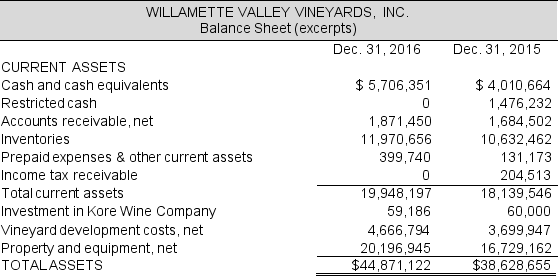The asset side of the 2016 balance sheet for Willamette Valley Vineyards is as follows:
 Continued next page
Continued next page
The following footnotes are from the annual report for Willamette Valley Vineyards for 2016.
Vineyard Development Costs
Vineyard development costs consist primarily of the costs of the vines and expenditures related to labor and materials to prepare the land and construct vine trellises. The costs are capitalized until the vineyard becomes commercially productive, at which time annual amortization is recognized using the straight-line method over the estimated economic useful life of the vineyard, which is estimated to be 30 years. Accumulated amortization of vineyard development costs aggregated $1,185,823 and $1,109,406 at December 31, 2016 and 2015, respectively.
Amortization of vineyard development costs are included in capitalized crop costs that in turn are included in inventory costs and ultimately become a component of cost of goods sold. For the years ending December 31, 2016 and 2015, approximately $76,417 and $75,669, respectively, was amortized into inventory costs.

 Required:
Required:
a. Explain the difference between Vineyard development costs and Land and improvements.
b. Calculate the percent used up of the Vineyard development costs.
c. Calculate the percent used up of the Property and equipment. What does this imply for future cash flows for Willamette Valley Vineyards?
d. Assume that on January 1, 2017 the company determined that the Vineyard development costs had a fair value of $4,000,000. How would this affect the company's balance sheet and income statement in 2017?
Correct Answer:
Verified
View Answer
Unlock this answer now
Get Access to more Verified Answers free of charge
Q48: The 2016 financial statements for Leggett &
Q49: The 2016 financial statements of Willamette Valley
Q50: The asset side of the 2016 balance
Q51: The asset side of the 2016 balance
Q52: The asset side of the 2017 balance
Q53: The Dow Chemical Corporation announced a restructuring
Q54: The 2016 income statement and balance sheet
Q55: Following are selected disclosures from Cabela's Inc.
Q57: How do companies test assets for impairment?
Q58: Firms typically report three categories of restructuring
Unlock this Answer For Free Now!
View this answer and more for free by performing one of the following actions

Scan the QR code to install the App and get 2 free unlocks

Unlock quizzes for free by uploading documents